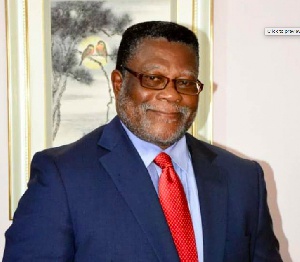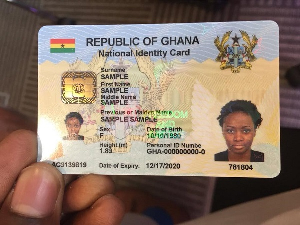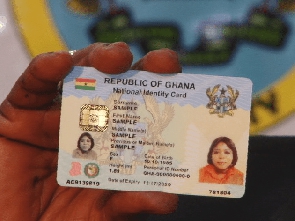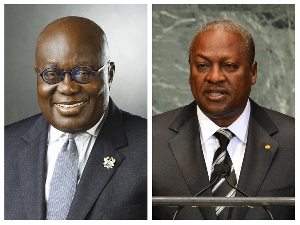 Dr. Kwame Ampofo, Former Chairman of Energy Commission
Dr. Kwame Ampofo, Former Chairman of Energy Commission
Preamble
The debate about whose administration resolved the dumsor menace still rages on and does not appear to be ending any time soon. Rather, it appears to have intensified and become a hot issue for political campaigns towards the 2020 general elections. At the centre of it, all are the two protagonists, President Nana Addo-Danquah Akufo-Addo and Former President John Dramani Mahama.
So, whilst President Akufo-Addo claims he came to resolve the power crisis, Former President John Dramani Mahama, has vehemently challenged him to “stop his false claims and tell Ghanaians how many megawatts of power he (Akufo-Addo) has added to the national grid, since assuming office”, to warrant his claim.
In this article, I seek to establish that, indeed, H.E. John Dramani Mahama, comprehensively fixed the power crisis (dumsor) before leaving office.
There is no doubt about that.
What Happened
Towards the end of 2012, the electricity supply system began to run into difficulties due to capacity inadequacies that were caused by low levels of water in the storage dams that produce the nation’s hydroelectric power, coupled with fuel supply challenges, that reduced the system’s ability to generate enough thermal power. The combined effect of those challenges resulted in a significant deficit (of about 800MW) in the available supply capacity of electricity, making the system no longer able to meet the growing demand of the population and of the productive sector of the national economy.
Profile of the Problem
It must be put on record that, since the advent of 4th Republican Constitutional Governance in 1992, the country has experienced four major power crises, one under each successive government, respectively and without exception (be they NDC or NPP). These crises occurred in 1998-2000 (under late former Pres. Rawlings), 2006-2007 (under former Pres. Kufour), 2011-2012 (under late former Pres. Mills) and 2013-2016 (under former Pres. Mahama). The latter one (2013 – 2016) was, no doubt, the most intense and most prolonged. Other than that, power supply deficits (dumsor) are really nothing new, as every single administration in this 4th Republican era had been faced with this challenge, at one point or the other.
All the above recorded and well documented incidents of electricity supply shortages have been attributed to poor rainfall that had kept the level of water in the Volta lake so low that the power output from the Hydropower Stations had been, correspondingly, critically low. That bad situation had been made worse by the non-availability of sufficient generating capacity from the available thermal units, mostly due to technical challenges (mechanical failures and maintenance issues). Contractual and financial difficulties in the procurement of fuel (natural gas and LCO) from Nigeria, to fire the thermal plants, were yet other reasons that had contributed to the incidence and peculiar nature of the last crisis, in particular.
Diagnosis
For the past decade or more, there has been rapid growth in Ghana’s electricity demand, estimated at 10% per annum, as at the period preceding the crisis. Per projections of the Energy Commission, such a high demand growth rate translated into about 200MW of capacity addition requirement every year. Similarly, the peak load (demand) had also been affected, increasing from about 900MW in 2003 to about 1800MW in 2013, a 100% increase over a period of just a decade.
As at 2012, just before the incidence of the last crisis, the total installed generation capacity was 2296 MW, made up of 1180MW of hydro power capacity and 1116MW of thermal generation capacity. Since the system had lost about 800MW of capacity, the remaining capacity of about 1,500MW could no longer match the high demand of about 1,800MW. In other words, the demand in the system had outstripped the capacity to supply, by about 300MW and, sometimes, even more.
The Policy Position
To resolve the situation, two options are always available:
a) Work to remove the imbalance between supply and demand (ie: manage the problem), or
b) Work to address the root causes of the crisis (fix the problem).
The preferred option employed by preceding governments had been option (a): to manage the problem by removing the imbalance and deferring action on (b).
Former President Mahama, however, decided that it was time to end the recurrence of the crises, altogether, and thus opted for the more holistic but difficult and lengthy path, that is, option (b), in addition to the short term solution under option (a). That is, to take the bull by the horn, so to speak, and to boldly take on the very root causes of the crises and to work towards the total elimination of “dumsor” and, thus, to strive for the attainment of a robust, long-lasting solution (ie: fixing the problem).
Thus, it will be recalled that, in his State of the Nation Address delivered to Parliament in February of 2015, Former President Mahama declared that: “I do not want to manage the problem, as has been the approach by previous administrations, but rather I am determined to “fix” the problem, once and for all”. To this end, former President Mahama took an entrenched policy position of focusing on the goal of attaining a long-term stability of the system.
Steps taken
The approach that former President Mahama’s NDC government adopted for resolving the issues responsible for the crisis, can be classified into three interconnected phases:
Phase I (Short-term): Managing the Crisis.
Here, the task was to work towards the rapid attainment of a balance between supply and demand; that is, the elimination of the disparity between supply capacity and demand for electrical power. So, under this phase, the response to the crisis was not different from the approaches used by all preceding governments, which are namely:
a) Institution of a rotational load-shedding programme (power rationing),
b) Embarkation on Solar and Renewable Energy Projects, in addition to Energy Conservation and Energy Efficiency measures. These included:
i. Implementation of the President’s National Rooftop Solar Programme. The target set for this programme was to attain 200,000 rooftops (equivalent to 100-200MWp), as quickly as was possible. The objective of this programme was to encourage households to, partially, take themselves off the national grid (by storing solar power during the day, for use at night) to free up a significant amount of power (during peak hours) for other users in the economy.
ii. Introduction of automatic timers that electronically isolates deep freezers and remove them from the load, particularly, at peak times. One million units of this device can shave off upto 250–300MW of the demand and avert load-shedding, during peak hours.
iii. Campaign to switch lighting loads from compact fluorescent lamps (CFL) to light emitting diode (LED) lamps and, thereby, further lower the demand for power at the peak times and make the system more efficient.
c) Procurement of emergency power generating plants, notably, Ameri and Karpowership.
Phase II (Medium-Term): Consolidating the short-term gains.
This involved initiatives such as:
1. Accelerating the progressive additions of thermal generation units, until available generation capacity exceeded peak demand, plus an adequate reserve margin of about 15-25% of the peak demand.
2. In the case of the last crisis, there was also the need to expedite the construction of the gas processing plant at Atuabo to produce indigenous lean gas for onward supply to the thermal plants at Aboadze, on a more reliable and sustainable manner. This is because, the non-availability of fuel to operate the thermal plants was a major contributing factor to the crisis.
3. Expediting investments to achieve a robust transmission network that would facilitate the efficient evacuation of the power produced in the national grid.
Phase III (Long-term): Extension of the solution into the future.
In this third phase, the Mahama administration proposed to address the challenges in procuring natural gas from Nigeria, through the WAGP, by constructing a pipeline to transport locally produced gas from Atuabo to the Tema enclave, either by a dedicated pipeline or by collaboration with WAGP to realise the reverse flow of gas from Aboadze to Tema. It is commendable that the Akufo-Addo regime saw the wisdom in Mahama’s proposition and decided to execute the project.
Expediting the restructuring and corporate reorganisation of ECG, to make it more efficient and to transform it into a reliable off-taker of power. The Mahama policy position was to attain this objective through Private Sector Participation (PSP) in ECG (what has, sadly, come to be known as the “PDS Scandal” under President Akufo-Addo).
The Outcome of the Policy Initiatives
The progressive policy initiatives of former President Mahama to tackle the root causes of the dumsor menace has, drastically, expanded and strengthened the very foundations of our electricity generation infrastructure and yielded several dividends, including:
• Procurement of emergency power plants such as the Karpowership (450MW) and the Ameri (250MW) Project, which is a BOT agreement and therefore becomes the bona-fide property of Ghana in 2021.
• The construction of the Natural Gas Processing Plant (Ghana Gas Company) at Atuabo, with capacity to handle over 300 mmscfpd of gas. Today, Ghana Gas is processing enough gas to produce about 900MW of electricity and most of the LPG consumed in the country.
• Development of a viable Solar PV industry in Ghana with over sixty registered local and international companies activity doing business in the country. This includes the construction of BXC's 20MW solar power plant near Winneba (largest in West Africa, at the time) and attests to the progress made in the renewable energy sub-sector, as an offspring of Mahama’s policies in fixing “dumsor”.
• Construction of more thermal power plants, to take care of the Medium-Term (2016 to 2021) needs of the economy. These include: Amandi (190MW); AKSA (370MW) and Early Power (190MW) - which is still under construction.
• In addition to the above projects of the NDC, under former President Mahama, the 220MW Kpone Thermal Power Plant, initiated by former President Kuffour, was also completed.
So, in all, before leaving office, H.E. John Mahama added to the existing national stock of power plants, more than 1260MW of new generating capacity to end dumsor and also ensure stability in the national electricity supply system for the next ten years (2016 - 2025).
Concluding Remarks
In conclusion, H.E. Former President John Dramani Mahama’s determination to fix Ghana’s perennial power crises was totally achieved at the end of December 2015 and was officially declared in February, 2016, in his State of the Nation Address to Parliament, prior to his exit from office. In that address, Former President Mahama declared that “the promise I made last year to “fix" the dumsor problem is on track”. This was ten (10) clear months before the advent of President Akufo-Addo’s government.
So, the stability in electricity supply that we are currently enjoying is thanks to the foresight and hard work of H.E. John Mahama and there should be no argument, whatsoever, as to who resolved the last power crisis. It was Former President John Dramani Mahama, and nobody else!
Dr. Kwame Ampofo
(Former Chairman, Energy Commission)










